Maybe if the private schoolboy from Melbourne had not rented such a flash car on his fact-finding trip to the US he wouldn’t have been noticed - but a gleaming silver Thunderbird is a head-turner even in laid-back San Francisco.
And maybe if he hadn’t given the rental company an address in Oakland's Foothill Boulevard which happened to be the headquarters of the Hells Angels' mother chapter, Peter John Hill could have slipped in and out as just another Aussie tourist looking for a Californian adventure.
When the Diamond Jubilee T-Bird was seen on a Hells Angels run in Lake County it was duly recorded and the driver became a person of curiosity. Issued a speeding ticket, he gave a dodgy address - next door to the mother chapter. When he failed to pay the ticket, an arrest warrant was issued. Now he was a person of interest.
Nearly three weeks later the car was seen at Golf Links Road, Oakland, outside the home of Hells Angels hitman James ‘‘Jim Jim’’ Brandes. He was also known as The Assassin, with good reason.
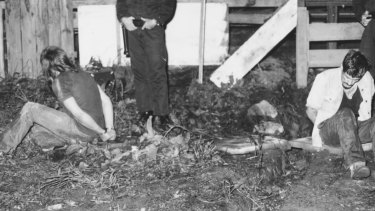
The gotcha moment: Hells Angels arrested at their drug lab in Queensland. It was only the start of the battle.
Hill was 24 and had joined the Melbourne chapter of the Hells Angels - a group of toughies living on the fringes of the law. Hill’s visits to the US would change all that.
From the time Hill returned to Australia he would help turn the local gang into an organised crime group - and change the face of the national drug culture forever.
It turned out Hill flew to the US four times to link up with the Hells Angels and was taken into a maximum-security prison to meet Oakland chapter president Sergey Walton. It was no social call, as Walton whispered to Hill the recipe to make methamphetamine - a drug hardly seen in Australia.
Hill was more than able to return the favour, becoming a smuggler of a key ingredient in the manufacture of speed - the liquid chemical P2P, illegal in the US but legal in Australia.
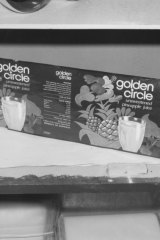
Pineapple juice labels used to smuggle chemicals to the US Hells Angels.Credit:Victoria Police
Meanwhile Hill was experimenting with the amphetamine recipe - and through trial and error improved the yield to commercial standards.
It was January 1982 when Detective Sergeant Steele Waterman returned for another stint in the drug squad. The summer cannabis crops had hit the street while the greatest challenge was an epidemic of heroin overdoses. No one was looking for speed labs and no one would have - except for an observant grandmother called Mrs Brown who lived in a farm on the outskirts of Melbourne, near Hurstbridge.
It was dead quiet out there, which is why Mrs Brown always heard the hotted-up cars and Harley-Davidsons turning up at the rented property across the road.
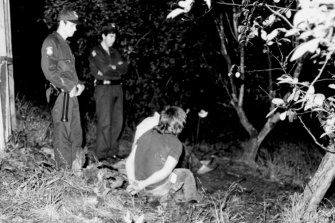
Hells Angels arrested at Greenslopes in 1982.Credit:Victoria Police.
Hill recruited key members of the gang to help him cook and distribute the drugs, including Roger Biddlestone, Raymond Hamment and John Paul Madden.
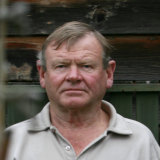
Former undercover officer Bob Armstrong in 2008.Credit:Michael Clayton-Jones
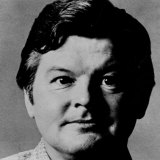
Benny Hill in 1975.Credit:Age archive
Once when they went to Sydney, Armstrong tipped off local detectives who raided the hotel. “He told the detectives up there to say ‘Bob says hello’.”
With 175 witnesses, listening devices, 640 exhibits including a machine gun, two pistols, cash, 16 sticks of gelignite, 32 electric detonators and a large amount of liquid speed, police were confident of a guilty verdict - but the four bikies looked cocky and with good reason.
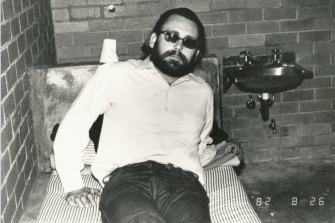
James "Jim Jim" Brandes, aka Sleepy Jim, was sent from the US to Australia by the Hells Angels to kill policemen Bob Armstrong and Steele Waterman. Seen here after being detained at Melbourne Airport in August 1982.
But it was no joke. A search of Brandes' luggage showed he had instructions on how to build a car bomb, the names of jurors in a US trial, a Treasury investigation handbook and a set of thumb cuffs. Immigration refused him entry and he was sent back on the same plane later that day.
And maybe if he hadn’t given the rental company an address in Oakland's Foothill Boulevard which happened to be the headquarters of the Hells Angels' mother chapter, Peter John Hill could have slipped in and out as just another Aussie tourist looking for a Californian adventure.
When the Diamond Jubilee T-Bird was seen on a Hells Angels run in Lake County it was duly recorded and the driver became a person of curiosity. Issued a speeding ticket, he gave a dodgy address - next door to the mother chapter. When he failed to pay the ticket, an arrest warrant was issued. Now he was a person of interest.
Nearly three weeks later the car was seen at Golf Links Road, Oakland, outside the home of Hells Angels hitman James ‘‘Jim Jim’’ Brandes. He was also known as The Assassin, with good reason.

The gotcha moment: Hells Angels arrested at their drug lab in Queensland. It was only the start of the battle.
Hill was 24 and had joined the Melbourne chapter of the Hells Angels - a group of toughies living on the fringes of the law. Hill’s visits to the US would change all that.
From the time Hill returned to Australia he would help turn the local gang into an organised crime group - and change the face of the national drug culture forever.
It turned out Hill flew to the US four times to link up with the Hells Angels and was taken into a maximum-security prison to meet Oakland chapter president Sergey Walton. It was no social call, as Walton whispered to Hill the recipe to make methamphetamine - a drug hardly seen in Australia.
Hill was more than able to return the favour, becoming a smuggler of a key ingredient in the manufacture of speed - the liquid chemical P2P, illegal in the US but legal in Australia.
Hill poured the chemical into three-litre Golden Circle pineapple juice tins and resealed them using a machine stolen from a Queensland canning company - sending six litres a time in the post. He sent more than 200 litres that helped the Hells Angels make $30 million to fund their defence in organised crime trials.

Pineapple juice labels used to smuggle chemicals to the US Hells Angels.Credit:Victoria Police
Meanwhile Hill was experimenting with the amphetamine recipe - and through trial and error improved the yield to commercial standards.
It was January 1982 when Detective Sergeant Steele Waterman returned for another stint in the drug squad. The summer cannabis crops had hit the street while the greatest challenge was an epidemic of heroin overdoses. No one was looking for speed labs and no one would have - except for an observant grandmother called Mrs Brown who lived in a farm on the outskirts of Melbourne, near Hurstbridge.
It was dead quiet out there, which is why Mrs Brown always heard the hotted-up cars and Harley-Davidsons turning up at the rented property across the road.
She contacted the Heidelberg police, who put her onto Bob Armstrong from the Bureau of Criminal Intelligence (BCI). Armstrong asked her to jot down a few car numbers, which duly came up as owned by members of the Hells Angels.
Armstrong snuck out with a BCI locksmith and broke in to find a working chemical lab plus gelignite, detonators, a machine gun and an unhealthy number of handguns. And so the first anti-bikie taskforce - Omega - was formed. Armstrong and Waterman were the operational leaders and effectively went to war with the Angels.
“Peter had an infectious personality. He fell in love with bikes. He joined them when they were just a bunch of baggy-arsed kids hanging out the front of a hamburger shop,” says Waterman.
Armstrong snuck out with a BCI locksmith and broke in to find a working chemical lab plus gelignite, detonators, a machine gun and an unhealthy number of handguns. And so the first anti-bikie taskforce - Omega - was formed. Armstrong and Waterman were the operational leaders and effectively went to war with the Angels.
“Peter had an infectious personality. He fell in love with bikes. He joined them when they were just a bunch of baggy-arsed kids hanging out the front of a hamburger shop,” says Waterman.

Hells Angels arrested at Greenslopes in 1982.Credit:Victoria Police.
Hill recruited key members of the gang to help him cook and distribute the drugs, including Roger Biddlestone, Raymond Hamment and John Paul Madden.
Hamment, Waterman says, was the money man, funding the first drug "cooks" from safe-crackings.
“Roger [Biddlestone] was not a bad guy, I didn’t mind him. He was Hilly’s best mate. Madden had the personality of a dead rat. I didn’t like him and he didn’t like us. He was an imposing figure and if he came to you with a pound of product and said you owed $30,000 you’d pay.”
When they were up and running they were producing $300,000 worth of speed per week, supplemented by a first-division Tattslotto win of $280,000.
On March 10, 1982, all four suspects were arrested at Greenslopes in Queensland, but it was only the start of a battle that would take five years, four trials, a mysterious death, a corrupted jury and an international murder plot.
“Roger [Biddlestone] was not a bad guy, I didn’t mind him. He was Hilly’s best mate. Madden had the personality of a dead rat. I didn’t like him and he didn’t like us. He was an imposing figure and if he came to you with a pound of product and said you owed $30,000 you’d pay.”
When they were up and running they were producing $300,000 worth of speed per week, supplemented by a first-division Tattslotto win of $280,000.
On March 10, 1982, all four suspects were arrested at Greenslopes in Queensland, but it was only the start of a battle that would take five years, four trials, a mysterious death, a corrupted jury and an international murder plot.

Former undercover officer Bob Armstrong in 2008.Credit:Michael Clayton-Jones
There were many more raids and the bikies took a particular dislike to Armstrong, referring to him as Noddy and Benny Hill (due to his purported resemblance to the British comic).
“Bob was pretty sharp. Bob used to pepper them all the time. He chased them and when a guy drove into the headquarters he followed them. He didn’t take a backward step. He would have their bikes pulled over and declared unroadworthy to get them off the road,” says Waterman.
“Bob was pretty sharp. Bob used to pepper them all the time. He chased them and when a guy drove into the headquarters he followed them. He didn’t take a backward step. He would have their bikes pulled over and declared unroadworthy to get them off the road,” says Waterman.

Benny Hill in 1975.Credit:Age archive
Once when they went to Sydney, Armstrong tipped off local detectives who raided the hotel. “He told the detectives up there to say ‘Bob says hello’.”
With 175 witnesses, listening devices, 640 exhibits including a machine gun, two pistols, cash, 16 sticks of gelignite, 32 electric detonators and a large amount of liquid speed, police were confident of a guilty verdict - but the four bikies looked cocky and with good reason.
Another bikie arrested in a follow-up raid was Anton Kenny. ‘‘His wrists were so huge you couldn’t get handcuffs around them,’’ says Waterman. Much later he was murdered and dismembered with a chainsaw.
After a monster trial, one juror wouldn’t budge and the jury could not reach a verdict. Much later Hill would tell police the jury had been nobbled. Waterman says the Angels paid $10,000 to the one juror, who “was a friend of a friend of one of the bikies”.
Much later “Hilly admitted that they got to one of the jurors. He was coy about it but he said they paid him”, Waterman says.
“One late afternoon I got a phone call from a lady. She said: 'Mr Waterman, Peter and his friends have been here discussing something. They are getting someone from America to come out to kill you and Mr Armstrong. He is from the Hells Angels.’ It was Audrey, Peter Hill’s mother. She was a lovely lady.
“I thought 'gee, that’s a bit savage'.
After a monster trial, one juror wouldn’t budge and the jury could not reach a verdict. Much later Hill would tell police the jury had been nobbled. Waterman says the Angels paid $10,000 to the one juror, who “was a friend of a friend of one of the bikies”.
Much later “Hilly admitted that they got to one of the jurors. He was coy about it but he said they paid him”, Waterman says.
“One late afternoon I got a phone call from a lady. She said: 'Mr Waterman, Peter and his friends have been here discussing something. They are getting someone from America to come out to kill you and Mr Armstrong. He is from the Hells Angels.’ It was Audrey, Peter Hill’s mother. She was a lovely lady.
“I thought 'gee, that’s a bit savage'.
"I went to BCI and got all the names of the Oakland chapter and had 28 put on alert. Next morning I got a phone call from immigration saying they had someone with one of those names here and he was in the cell [at Melbourne Airport].”
It was ‘‘Sleepy Jim’’ Brandes, who along with killing bikie associates had bombed and seriously injured US policeman Bill Zerby in January 1978.
“When we walked in he looked at Bob and said, ‘Jesus, you do look like Benny Hill’.”
It was ‘‘Sleepy Jim’’ Brandes, who along with killing bikie associates had bombed and seriously injured US policeman Bill Zerby in January 1978.
“When we walked in he looked at Bob and said, ‘Jesus, you do look like Benny Hill’.”

James "Jim Jim" Brandes, aka Sleepy Jim, was sent from the US to Australia by the Hells Angels to kill policemen Bob Armstrong and Steele Waterman. Seen here after being detained at Melbourne Airport in August 1982.
But it was no joke. A search of Brandes' luggage showed he had instructions on how to build a car bomb, the names of jurors in a US trial, a Treasury investigation handbook and a set of thumb cuffs. Immigration refused him entry and he was sent back on the same plane later that day.
Madden died in what was declared a car accident. On a bikie run the enforcer was run over by the club's own backup van. “Madden had run out of money and he was starting to give indications that he might cut a deal. He was about to talk turkey," Waterman says.
“He was dead and buried before we knew about it. They tidied that one up nicely.”
Waterman says there was a falling-out over the money and drugs. “All of a sudden Roger Biddlestone turns up in a roll of carpet having had the absolute crap beaten out of him. He’d been hit with a baseball bat to within an inch of his life.”
With Madden dead and Biddlestone neutralised, “Hilly was out on a limb. Bob and I went see him and thrashed out a deal in an hour-and-a-half over burgers and fries. Hilly could out-eat both of us.
He just kept ordering more fries.”
He wanted a reduced sentence and to do his time well away from the others. After three trials - a hung jury and two aborted hearings - the prosecutors jumped at the deal. Faced with Hill’s statements taken at the Sofitel Hotel (“We had a few bourbons at the Piano Bar to warm him up’’), the others pleaded guilty.
“He was dead and buried before we knew about it. They tidied that one up nicely.”
Waterman says there was a falling-out over the money and drugs. “All of a sudden Roger Biddlestone turns up in a roll of carpet having had the absolute crap beaten out of him. He’d been hit with a baseball bat to within an inch of his life.”
With Madden dead and Biddlestone neutralised, “Hilly was out on a limb. Bob and I went see him and thrashed out a deal in an hour-and-a-half over burgers and fries. Hilly could out-eat both of us.
He just kept ordering more fries.”
He wanted a reduced sentence and to do his time well away from the others. After three trials - a hung jury and two aborted hearings - the prosecutors jumped at the deal. Faced with Hill’s statements taken at the Sofitel Hotel (“We had a few bourbons at the Piano Bar to warm him up’’), the others pleaded guilty.
Hill did his time and has kept out of trouble, first as a truck driver and later as a block owner up around Mildura. It is said that to stick it up the Hells Angels he sold his speed recipe to the head of the rival Black Uhlans, a bloke called John William Samuel Higgs who became Australia’s most prodigious drug manufacturer.
All because Peter Hill was curious enough to visit the mother chapter in Oakland.
Australia - BNN.
All because Peter Hill was curious enough to visit the mother chapter in Oakland.
Australia - BNN.

This is my first time i visit here and I found so many interesting stuff in your blog especially it's discussion, thank you.locksmith near me
ReplyDelete